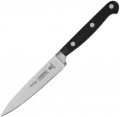Steel grade
The name of the steel grade from which the knife blade is made.
Its working properties directly depend on the type of steel — hardness, brittleness, tendency to corrosion, ability to keep sharpening, etc. Accordingly, this parameter largely determines the features of the knife as a whole. Many different grades of steel are used in modern kitchen knives; knowing the name of a particular brand, you can find detailed information about it (physical characteristics, reviews, user reviews) and evaluate the quality and overall level of the tool.
Plastic type
The type of plastic used in a knife handle.
See "Handle Material" for general features of this material. The specific types of plastic found in modern kitchen knives are very diverse in price and quality. In low-cost models, the following options are mainly used:
— ABS plastic. One of the most inexpensive varieties of plastic; relatively fragile and brittle material that does not tolerate heat, temperature extremes and exposure to the sun. However, with proper quality and careful handling, such a handle can last quite a long time.
— Polycarbonate. More advanced than ABS, and at the same time quite affordable kind of plastic. It is thanks to this combination of affordability and practicality that polycarbonate is popular in the market.
— Polypropylene. Polypropylene is notable primarily for its light weight and high hardness, making it highly resistant to abrasion and scratches. This material is sensitive to sunlight and oxygen, but these shortcomings are often compensated by the use of special additives. Also, polypropylene can be supplemented with elastomer — a soft and elastic material that makes the handle more pleasant to the touch.
— Bakelite. One of the first plastics in history that still has not lost its relevance. One of the interesting features of bakelite is heat resistance: even on an open fire, such material is charred, but does not melt or burn.
In turn, premium knives can be used, in particular, the followin...g types of plastics:
— G10. One of the varieties of fibreglass is glass fibre with a plastic filler. G10 is characterized by excellent strength and durability, this material perfectly tolerates moisture and temperature changes, and it is quite difficult to scratch it. Fibreglass weighs much more than carbon fibre; on the other hand, its price is much lower.
— Carbon fibre (carbon fibre, Carbon Fibre, etc.). Composite material in the form of carbon fibre threads filled with plastic filler. This combination provides low weight and at the same time extremely high strength — even relatively simple grades of carbon fibre are not inferior to steel in this respect. However and these handles are not cheap. In addition, this material is sensitive to specific loads, namely point impacts — this may cause cracks on it. However, for such a "trouble", most likely, a very unfortunate set of circumstances will be required.
— Mikarta. Composite material, a kind of textolite, consisting of layers of fibrous material filled with polymer. The composition of the base and the filler may be different, sometimes it is displayed directly in the title — for example, Canvas Micarta uses fabric as the base (canvas — canvas). At the same time, regardless of the varieties, the manufacturing technology of such a handle involves high-pressure sintering. Due to this, a very strong, reliable and durable material is obtained, insensitive to moisture, high temperatures and sunlight, pleasant in appearance and to the touch. With all this, micarta is inexpensive, it is suitable even for low-cost kitchen knives.
— Packawood. Material based on laminated wood combined with synthetic resins. For such handles, different types of wood can be used, which allows you to get different patterns on the surface; and the possibility of using coloring additives further expands the variety of design of such knives. Externally, such handles are indistinguishable from wooden ones, but they are much harder, stronger and more resistant to moisture.
Hardness
The hardness of the metal used in the knife blade. Indicated in standard HRC units (according to Rockwell); the higher the value, the harder the blade.
This parameter in knives has a double meaning. On the one hand, the blade must be hard enough so as not to dull prematurely, not form burrs and not deform when bent; on the other hand, it must remain soft in order to sharpen normally, not crack or break (brittleness also increases with increasing hardness). In most kitchen knives, the hardness is in the range of 52 - 62 HRC - it is believed that this range provides the optimal ratio of strength, reliability and ease of sharpening.
In general, ceteris paribus, a knife made of softer steel will have to be sharpened or adjusted more often with musat, however, such procedures themselves will take a little time and effort. Conversely, a hard blade will hold sharpening for a long time, however, you will have to try to restore it.
Full tang (increased strength)
Knives for operations and work, in which there are increased loads on the blade and handle. The shank of the blade in their design continues until the end of the handle, usually it has the same thickness as the blade. The handle itself usually consists of two pads, planted on rivets or hidden pins. But there are other versions: with a solid metal or cast polymer handle. In such cases
Full tang knives can be identified by several distinguishing features – a protruding shank at the end, a lanyard hole through which a metal shank is visible, etc.
